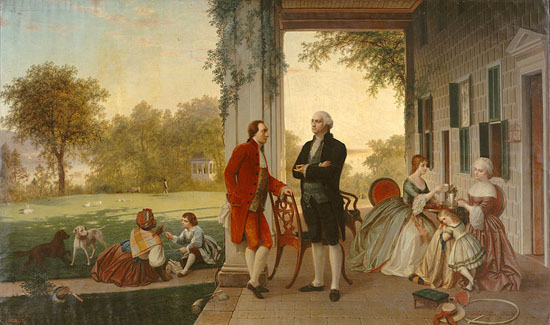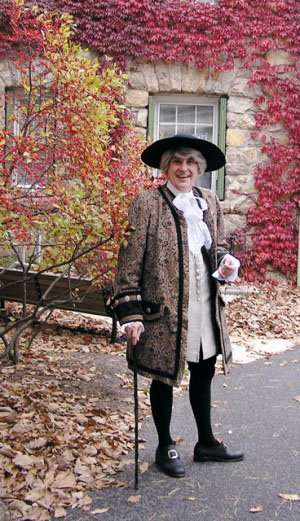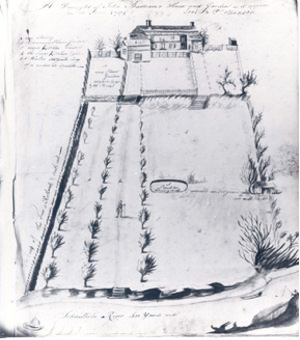home | internet service | web design | business directory | bulletin board | advertise | events calendar | contact | weather | cams

|
What do you call a hunky rich smart guy  Washington and Lafayette at Mount Vernon. Painting by Rossiter and Mignot,1859 Washington and Lafayette at Mount Vernon. Painting by Rossiter and Mignot,1859You call him George. George Washington. Please let me tell you about my gardening hero. We know from his letters and journals that Washington calmed his mind and eased his soul during the War of Independence and during his presidency with thoughts and plans of his garden at Mount Vernon. For example, while awaiting the imminent attack of 73 British warships on New York, Washington filled the time planning and directing tree planting at Mount Vernon. They were to be only trees native to America. British species were expressly forbidden. Washington may have been our first all-native-plant ornamental garden designer. He wisely started his landscape plantings with trees. (Trees form the framework and, of course, take the longest time to grow to an effective size.) During the war he recommended the troops make regimental gardens to produce food for the men to eat AND because it would be healthy and comforting work. When he marched his army through Philadelphia he directed them to wear green branches upon their heads as a sign of hope. Now they call all this horticultural therapy.  Lecturer Kirk Brown, Horticulturist and Dramatist of Philadelphia, reenacts John Bartram Lecturer Kirk Brown, Horticulturist and Dramatist of Philadelphia, reenacts John BartramAfter the war, on his way back home to his beloved Mount Vernon, he stopped in New York to order the latest best-selling book, the Gardeners Dictionary by Philip Miller. I suppose it was then acceptable to purchase a British book given he had just defeated them in battle. Miller had received and cultivated plants from all 13 colonies in the Chelsea Physic Garden of London and knew more than anyone about American plants except our own John Bartram. Washington read all he could find of agricultural and horticulture science. The "Father of Our Country" believed in science. After the war was over a new challenge presented itself: the forming of a government. Things were not going so well and after many months of haggling and a long week of fruitless discussion the men were hanging out in the tavern. (Apparently, nothing has changed in politics.) Some of the in-crowd had planned an excursion to Bartram's Garden and the word got out about the trip the next day. Plus, everyone knew Washington had just stopped by Bartram's to put in his extensive plant order and Washington was cool. The party crashers were welcomed and the visit went as planned the next day. The men had a great time and were particularly impressed with the mature plants from all 13 colonies growing and thriving beautifully together. There was no other place in America where the botanical wealth of America could be seen. Just two days later, on July 16, 1787, the key delegates who enjoyed the outing changed position and the great compromise was reached. We had a Constitution. The felicitous visit to the internationally celebrated garden is credited by some historians for breaking the deadlock of distrust and discord among key delegates. Did you think our country was founded with only bullets? Nope. It took a garden to finish the job. Stay with me here, there is more. Washington's garden at Mount Vernon was impressive. He selected plants for seasonal interest. He combined food plants with ornamental. He planned a strolling path to bring people through the garden to experience both formal and informal elements. He worked to integrate the big commanding white house with the surrounding landscape. His experimental garden for private botanical projects was enclosed so he could work outside the public eye (his home was a mecca for endless pilgrims).He tested exotic fodder grasses, grains, nuts, pears, grapes, and peaches for potential economic and agricultural use in America He fenced a deer park, fencing deer in, not out. This guy was serious about it all and so far ahead that we common folk are just now catching on.  A 1758 drawing of John Bartram's garden. A 1758 drawing of John Bartram's garden.George had a sense of humor. He built a ‘necessary’ in the middle of each side of the strolling shrubberies. The toilet was enclosed in a handsome little octagonal ‘temple’. Fragrant plantings surrounded each temple and he used the human manure for fertilizer. He believed in stewardship and sustainability and acted upon his beliefs. He turned from growing tobacco to wheat on the estate largely because tobacco depleted the soil and he believed, as an export, it was ruinous for America. Tobacco was sold primarily to England and, thereby, it put America in economic chains to the oppressor. American tobacco farmers would make short-term profits at the long-term cost of their soil fertility and economic independence. And if this all is not enough, I have another donkey story to tell. In those days, the best donkeys in the world were owned and regulated by kings (they still are in Jordan). Washington requested and was given the finest of donkeys from the King of Spain, the King of France and Lafayette. Washington bred the jacks to good horses to produce a quality mule. By 1788 he took subscriptions for stud service. Good genetics were not just for royalty in this new land. In the time before fossil fuel, the mule was strong reliable energy for agriculture and transportation. For many years America would need the service of the humble donkey and hard-working mule and George knew it. He did this for us. George Washington, a whole lot more than just our first President. Celebrate President's Day like you mean it this year. Thanks for reading, PS: Actually, another hunky smart rich guy who loves gardening is none other than Brad Pitt, but it isn't his birthday. 2/17/2012 Comments Thank you for giving us an alternate look at our first president. I wonder how many of our military leaders these days are gardeners. Love of the land is good. I was also relieved to find that it was not a picture of you, Jane, in costume. It did make me wonder if it has been too long since I've seen you. Gloria Spiwak West Boesel
|